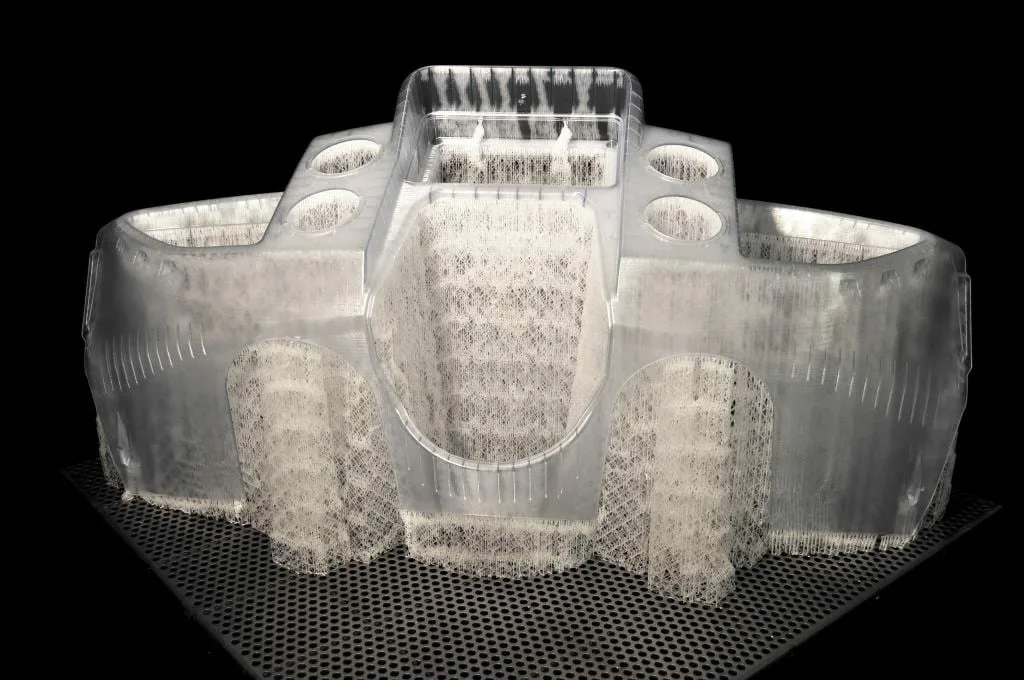Introduction
In the ever-evolving landscape of manufacturing, the quest for efficiency, precision, and innovation is relentless. Imagine a world where custom tools can be designed and produced with unparalleled accuracy, significantly reducing lead times and costs. This isn’t just a futuristic vision; it’s the reality brought to life by Stereolithography (SLA) 3D printing.
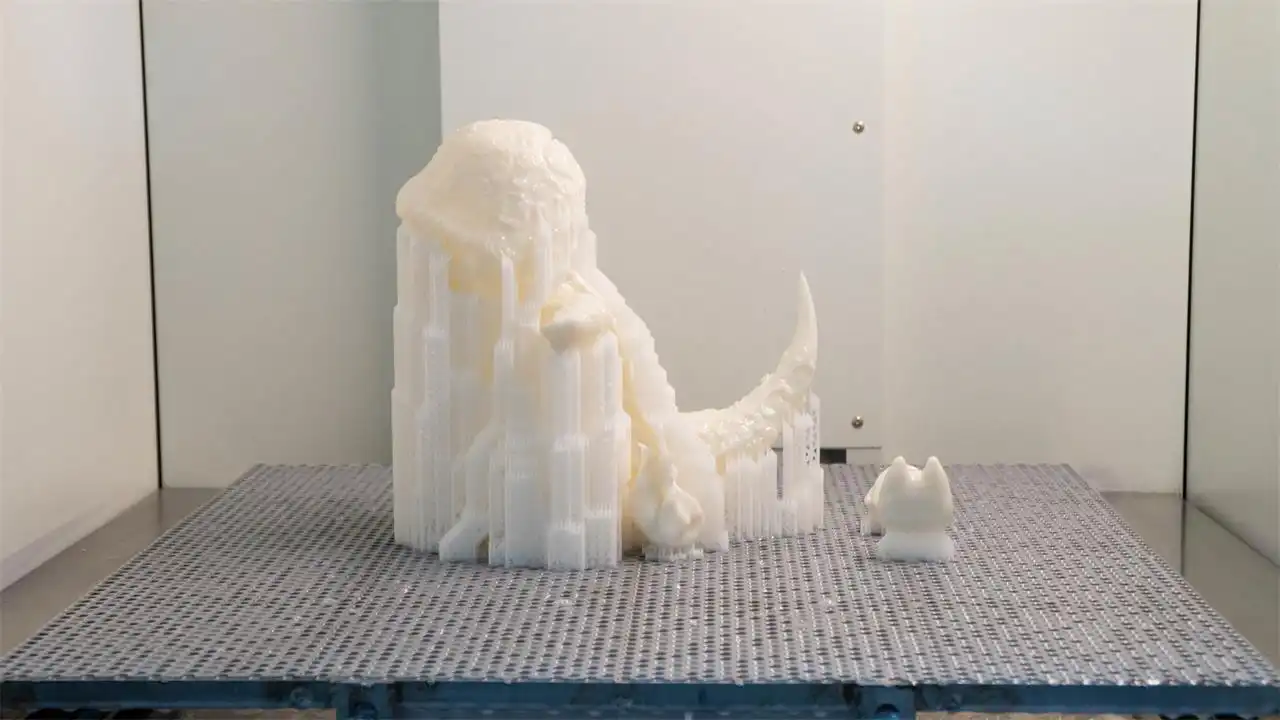
SLA 3D printing has revolutionized the way we approach custom tooling, offering a myriad of benefits that traditional manufacturing methods simply can’t match. From injection molding to creating intricate jigs and fixtures, the applications are vast and varied. But what exactly is SLA 3D printing, and why is it becoming the go-to solution for custom tooling in modern production processes?
In this blog post, we will delve deep into the world of SLA 3D printing, exploring its history, technical aspects, and the profound impact it has on custom tooling. We’ll answer all the burning questions you might have, from understanding the materials used to the practical applications in various industries.
Understanding SLA 3D Printing
Stereolithography (SLA) 3D printing is a groundbreaking technology that has revolutionized the way we approach manufacturing, design, and prototyping. But what exactly is SLA 3D printing, and why is it such a game-changer?
Technical Overview
How does SLA 3D printing work?
SLA 3D printing is a type of additive manufacturing that uses a laser to cure liquid resin into hardened plastic. Here’s a step-by-step breakdown of the process:

- Design: A 3D model is created using CAD software.
- Slicing: The 3D model is sliced into thin layers using specialized software.
- Printing: The printer’s laser traces each layer’s shape on the surface of a vat of liquid resin, hardening the resin where it hits.
- Layer-by-Layer Building: The build platform lowers slightly, and the process repeats, building the object layer by layer.
- Post-Processing: The printed object is cleaned and cured to achieve the desired mechanical properties.
Key Components of an SLA 3D Printer
- Laser: UV laser that cures the resin.
- ResinVat: Container holding the liquid resin.
- Build Platform: Surface where the object is built.
- Gantry System: Mechanism that moves the laser and build platform.
Materials Used
Types of Resins Used in SLA Printing
SLA 3D printing primarily uses photopolymer resins, which are light-sensitive materials that harden when exposed to UV light. The choice of resin depends on the desired properties of the final product. Here are some common types:
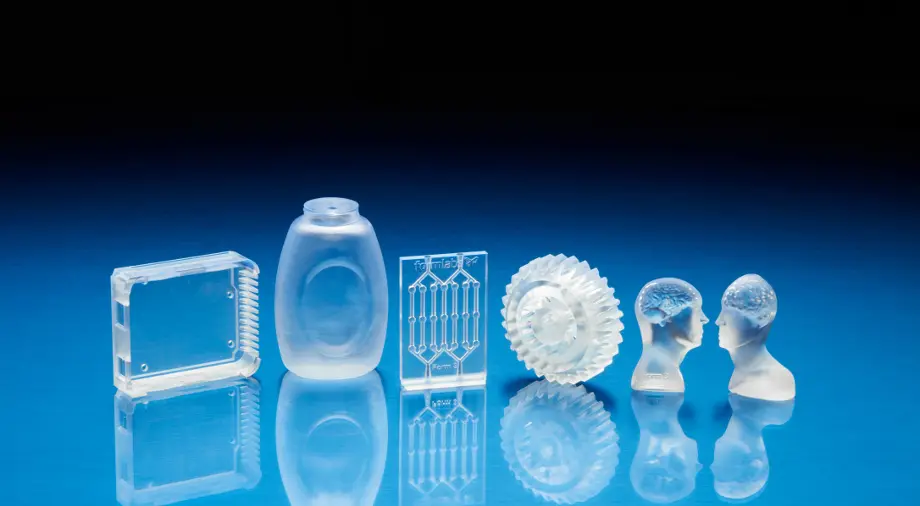
| Resin Type | Properties | Applications |
| Standard Resin | High detail, smooth finish | Prototyping, visual models |
| Tough Resin | Durable, impact-resistant | Functional prototypes, mechanical parts |
| Flexible Resin | Elastic, rubber-like | Gaskets, wearable items |
| High-Temp Resin | Heat-resistant, maintains strength | Mold making, casting |
| Bio-Compatible Resin | Safe for medical use, sterilizable | Dental models, medical devices |
Material Properties and Their Impact on Tooling
- Durability: Tough and high-temp resins are ideal for creating durable tools that can withstand rigorous use.
- Flexibility: Flexible resins are perfect for tools that require some degree of elasticity.
- Precision: Standard resins offer high precision, making them suitable for intricate designs and fine details.
- Safety: Bio-compatible resins are essential for medical applications where safety and sterilization are critical.
SLA 3D printing is a versatile and powerful technology that has transformed various industries by offering unparalleled precision, material variety, and design flexibility.
Whether you’re looking to produce high-detail prototypes, durable mechanical parts, or specialized medical devices, SLA 3D printing offers a solution that meets your needs.
Benefits of SLA 3D Printing for Custom Tooling
Stereolithography (SLA) 3D printing has emerged as a revolutionary technology in the realm of custom tooling. The precision, efficiency, and versatility it offers make it an invaluable asset for various industries.
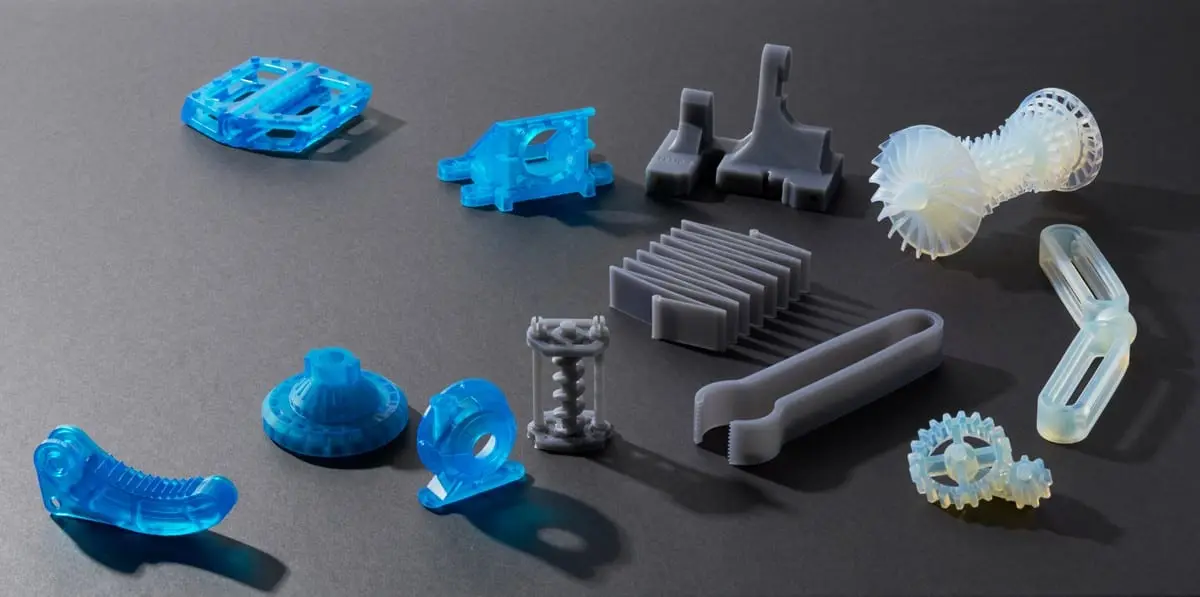
Precision and Accuracy
How Accurate is SLA 3D Printing?
SLA 3D printing is renowned for its exceptional precision and accuracy. The technology uses a highly focused laser to cure resin, enabling the creation of objects with intricate details and smooth surfaces. The typical layer thickness ranges from 25 to 100 microns, allowing for extremely fine resolutions.
Industries Requiring High Precision
- Dental and Medical: Custom dental molds, surgical guides, and prosthetics.
- Aerospace: Complex components requiring tight tolerances.
- Jewelry: Intricate designs and detailed prototypes.

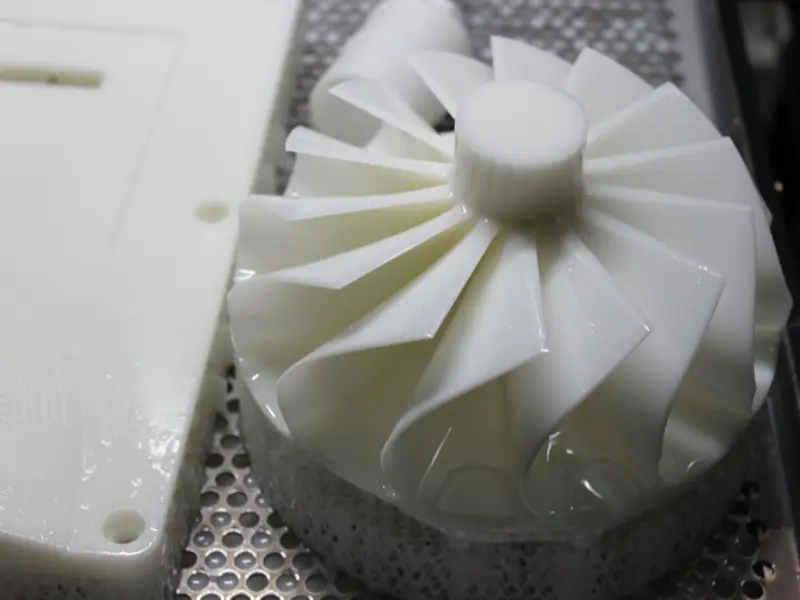
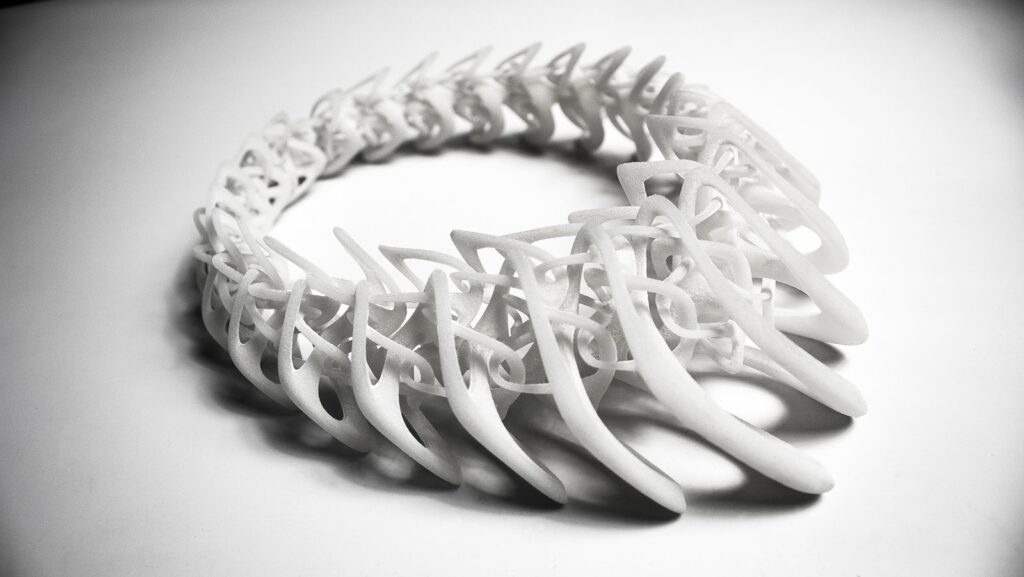
Speed and Efficiency
How Fast Can SLA 3D Printers Produce Tools?
SLA 3D printing is remarkably fast compared to traditional manufacturing methods. The speed of production depends on several factors, including the size and complexity of the object, as well as the printer’s specifications. However, SLA 3D printers can produce custom tools in a matter of hours, significantly reducing lead times.
Comparison with Traditional Manufacturing Methods
| Method | Lead Time | Setup Time | Production Speed |
| SLA 3D Printing | Hours to Days | Minimal | High (Layer-by-Layer) |
| CNC Machining | Days to Weeks | Extensive | Moderate |
| Injection Molding | Weeks to Months | Significant | High (Once Setup) |
Benefits for Production Efficiency
- Rapid Prototyping: Quick iteration cycles for design validation.
- On-Demand Manufacturing: Produce tools as needed, reducing inventory costs.
- Reduced Downtime: Fast production minimizes delays in the manufacturing process.
Cost-Effectiveness
Cost Comparison: SLA 3D Printing vs. Traditional Tooling Methods
One of the most significant advantages of SLA 3D printing is its cost-effectiveness. While the initial investment in a high-quality SLA 3D printer may be substantial, the long-term savings are considerable.
| Cost Factor | SLA 3D Printing | Traditional Methods |
| Initial Setup | Moderate to High | High |
| Material Costs | Moderate | High |
| Labor Costs | Low | High |
| Tooling Costs | Minimal | Significant |
Long-Term Savings and ROI
- Reduced Material Waste: SLA printing only uses the material needed for the part.
- Lower Labor Costs: Automation reduces the need for manual labor.
- Minimized Inventory Costs: On-demand production reduces the need for large inventories.
Design Flexibility
How Does SLA 3D Printing Enable Complex Geometries?
SLA 3D printing excels in creating complex geometries that are difficult or impossible to achieve with traditional methods. The layer-by-layer approach allows for intricate designs with internal features, undercuts, and overhangs.
Case Studies of Innovative Tool Designs
- Automotive Industry: Custom jigs and fixtures for assembly lines.
- Medical Sector: Custom surgical instruments and patient-specific implants.
- Consumer Products: Unique and ergonomic tool designs tailored to specific tasks.
Material Properties
Durability and Strength of SLA-Printed Tools
The choice of resin significantly impacts the mechanical properties of SLA-printed tools. Tough resins offer excellent durability and impact resistance, making them suitable for functional prototypes and mechanical parts.
Customization of Material Properties for Specific Applications
- Heat Resistance: High-temp resins for mold making and casting.
- Flexibility: Flexible resins for gaskets and wearable items.
- Bio-Compatibility: Bio-compatible resins for medical applications.
Common SLA Resins and Their Properties
| Resin Type | Property | Ideal Applications |
| Standard Resin | High Detail, Smooth Finish | Prototyping, Visual Models |
| Tough Resin | Durable, Impact-Resistant | Functional Prototypes, Mechanical Parts |
| Flexible Resin | Elastic, Rubber-Like | Gaskets, Wearable Items |
| High-Temp Resin | Heat-Resistant, Strong | Mold Making, Casting |
| Bio-Compatible Resin | Safe for Medical Use | Dental Models, Medical Devices |
SLA 3D printing offers a multitude of benefits for custom tooling, making it an indispensable tool in modern manufacturing. From its unparalleled precision and speed to its cost-effectiveness and design flexibility, SLA 3D printing provides solutions that traditional methods simply cannot match. By understanding these advantages, businesses can leverage SLA technology to streamline their production processes, reduce costs, and innovate like never before.
Applications in Custom Tooling
SLA 3D printing has become an indispensable tool in various industries, thanks to its ability to produce highly detailed and accurate components. But what are the specific applications of SLA 3D printing in custom tooling? In this article, we will delve into several key areas where SLA 3D printing excels, including injection molding, jigs and fixtures, casting and molding, and rapid prototyping. Each section will provide in-depth insights, real-world examples, and best practices to help you understand the transformative impact of SLA 3D printing on custom tooling.
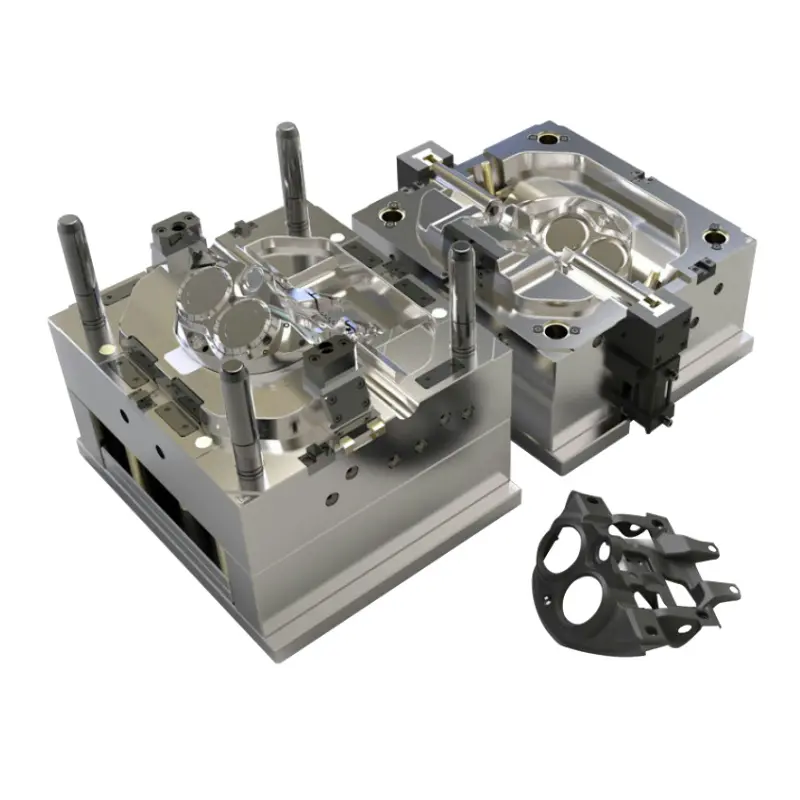
Injection Molding
How is SLA 3D Printing Used in Injection Molding?
Injection molding involves creating a mold, typically from metal, into which molten material is injected to form parts. SLA 3D printing can be used to create highly detailed and precise molds, significantly reducing the time and cost compared to traditional mold-making methods.
Benefits for Mold Making and Prototyping
- Rapid Iteration: Quickly produce and test multiple mold designs.
- Cost Savings: Lower material and labor costs compared to traditional mold-making.
- Complex Geometries: Easily create intricate mold features that are challenging with conventional techniques.
Case Study: Consumer Electronics
A leading consumer electronics company used SLA 3D printing to create molds for a new smartphone casing. By leveraging SLA technology, they were able to reduce the mold creation time from weeks to days, allowing for rapid iteration and testing of different designs. The result was a highly optimized mold that met all design and functional requirements.
Jigs and Fixtures
Custom Jigs and Fixtures for Assembly Lines
Jigs and fixtures are essential components in manufacturing, used to hold, guide, and support parts during assembly or machining. SLA 3D printing offers a fast and cost-effective way to produce custom jigs and fixtures tailored to specific tasks.
Real-World Examples of Improved Production Efficiency
- Automotive Industry: Custom fixtures for aligning and assembling complex automotive parts.
- Aerospace Sector: Specialized jigs for holding delicate components during assembly.
- Medical Devices: Custom fixtures for assembling intricate medical devices.
Benefits of SLA-Printed Jigs and Fixtures
| Benefit | Description |
| Reduced Lead Time | Quickly produce custom jigs and fixtures |
| Cost-Effective | Lower material and production costs |
| High Precision | Accurate and reliable holding and alignment |
| Design Flexibility | Easily create complex and ergonomic designs |
Casting and Molding
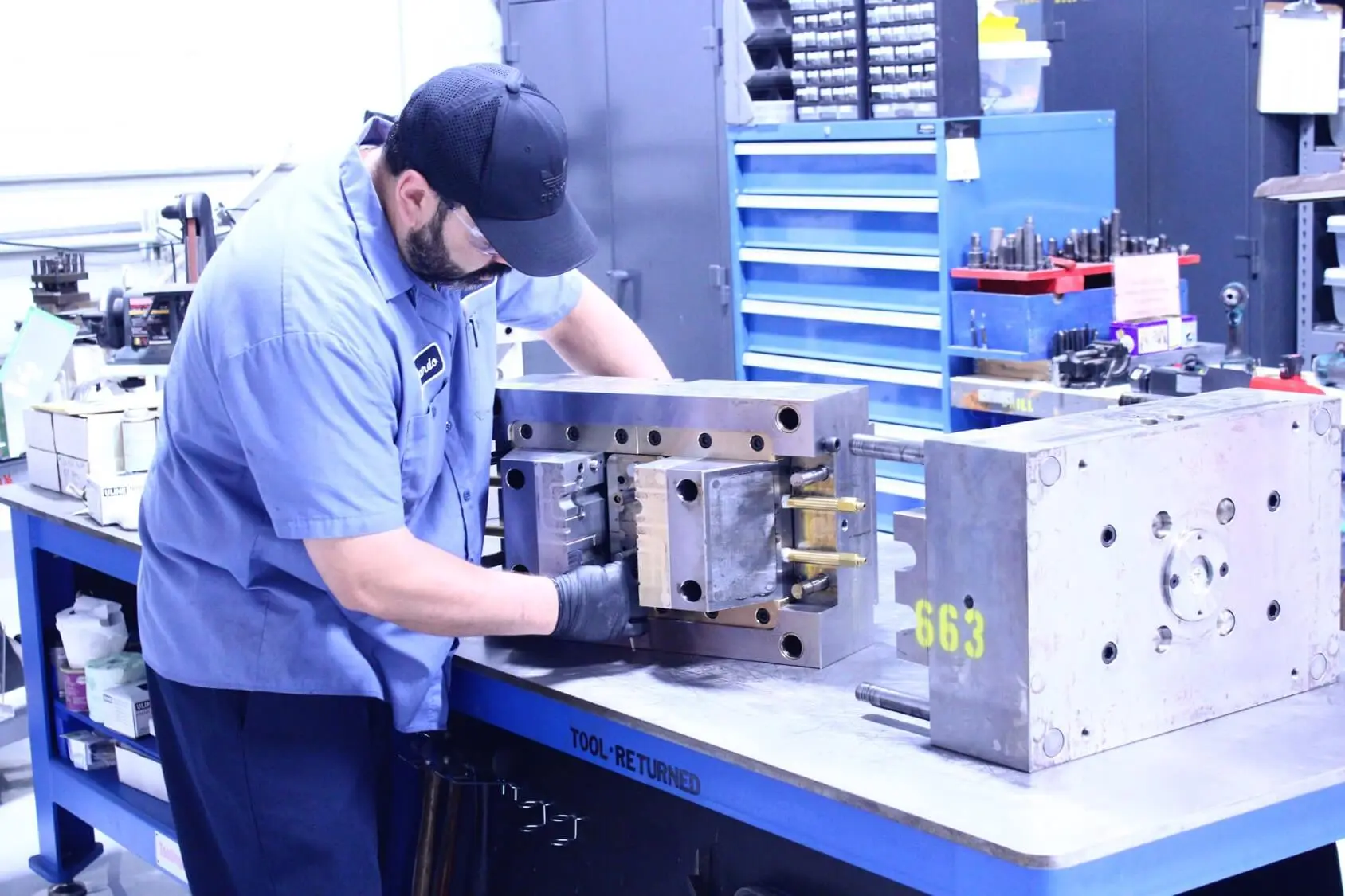
SLA 3D Printing for Master Patterns in Casting
Casting and molding processes often require master patterns to create molds. SLA 3D printing is ideal for producing these master patterns due to its high precision and ability to create intricate details.
Applications in Jewelry and Dental Industries
- Jewelry: Create highly detailed master patterns for lost-wax casting.
- Dental: Produce accurate master patterns for dental molds and prosthetics.
Case Study: Jewelry Manufacturing
A jewelry manufacturer used SLA 3D printing to create master patterns for intricate ring designs. The high level of detail and precision provided by SLA technology allowed them to produce molds that captured every nuance of the original design. This resulted in beautifully crafted jewelry pieces that met the highest standards of quality.
Rapid Prototyping
How Does SLA 3D Printing Speed Up Prototype Development?
Rapid prototyping involves quickly creating a scale model or prototype of a product to test its design and functionality. SLA 3D printing excels in this area due to its speed, precision, and ability to produce detailed prototypes.
Iterative Design Process and Its Advantages
- Quick Iterations: Rapidly produce and test multiple prototypes.
- Design Validation: Validate design concepts before moving to full-scale production.
- Cost Savings: Reduce costs associated with traditional prototyping methods.
Advantages of SLA 3D Printing in Rapid Prototyping
| Advantage | Description |
| Speed | Produce prototypes in hours or days |
| Precision | High level of detail and accuracy |
| Flexibility | Easily modify and iterate designs |
| Material Variety | Choose from a range of resins to match final product properties |
Case Study: Consumer Product Development
A startup developing a new consumer gadget used SLA 3D printing for rapid prototyping. They were able to produce multiple iterations of their design in a short period, allowing them to quickly test and refine their product. This accelerated their development timeline and ensured a high-quality final product.
The applications of SLA 3D printing in custom tooling are vast and varied, offering significant advantages in terms of speed, cost, and precision. Whether you’re producing injection molds, custom jigs and fixtures, master patterns for casting, or rapid prototypes, SLA 3D printing provides a versatile and efficient solution.
By understanding these applications and leveraging the capabilities of SLA technology, businesses can streamline their production processes, reduce costs, and bring innovative products to market faster.
Implementing SLA 3D Printing in Your Production Processes
SLA 3D printing offers transformative potential for custom tooling and other manufacturing applications. However, to fully leverage this technology, it’s crucial to understand how to implement it effectively within your production processes.
Design Considerations
Optimizing Designs for SLA Printing
Designing for SLA 3D printing involves different considerations compared to traditional manufacturing methods. Here are some key tips to keep in mind:
- Layer Orientation: The orientation of your design on the build platform can affect surface finish, strength, and print time.
- Support Structures: SLA prints often require support structures to prevent deformation and ensure accuracy. Design your model with minimal but effective supports.
- Wall Thickness: Ensure that walls are thick enough to be printed accurately but not so thick that they waste material or increase print time.
Common Design Mistakes to Avoid
- Overhangs and Unsupported Features: Avoid designing features that hang without adequate support, as they can lead to print failures.
- Too Thin Walls: Walls that are too thin may not print correctly and can be fragile.
- Complex Internal Structures: While SLA can handle complex geometries, overly intricate internal features may complicate post-processing.
Design Tips for SLA 3D Printing
| Design Aspect | Tip |
| Layer Orientation | Optimize for surface finish and strength |
| Support Structures | Design with minimal but effective supports |
| Wall Thickness | Balance between strength and material efficiency |
| Overhangs | Avoid or minimize unsupported features |
| Internal Structures | Simplify for easier post-processing |
Equipment Selection
Choosing the Right SLA 3D Printer
Selecting the appropriate SLA 3D printer depends on your specific needs, including the size of the parts you plan to produce, desired resolution, and production volume. Key considerations include:
- Build Volume: Ensure the printer can accommodate the size of your largest parts.
- Resolution: Higher resolution printers produce finer details but may be slower.
- Material Compatibility: Verify that the printer supports the resins you plan to use.
Top SLA 3D Printers on the Market
Formlabs Form 4
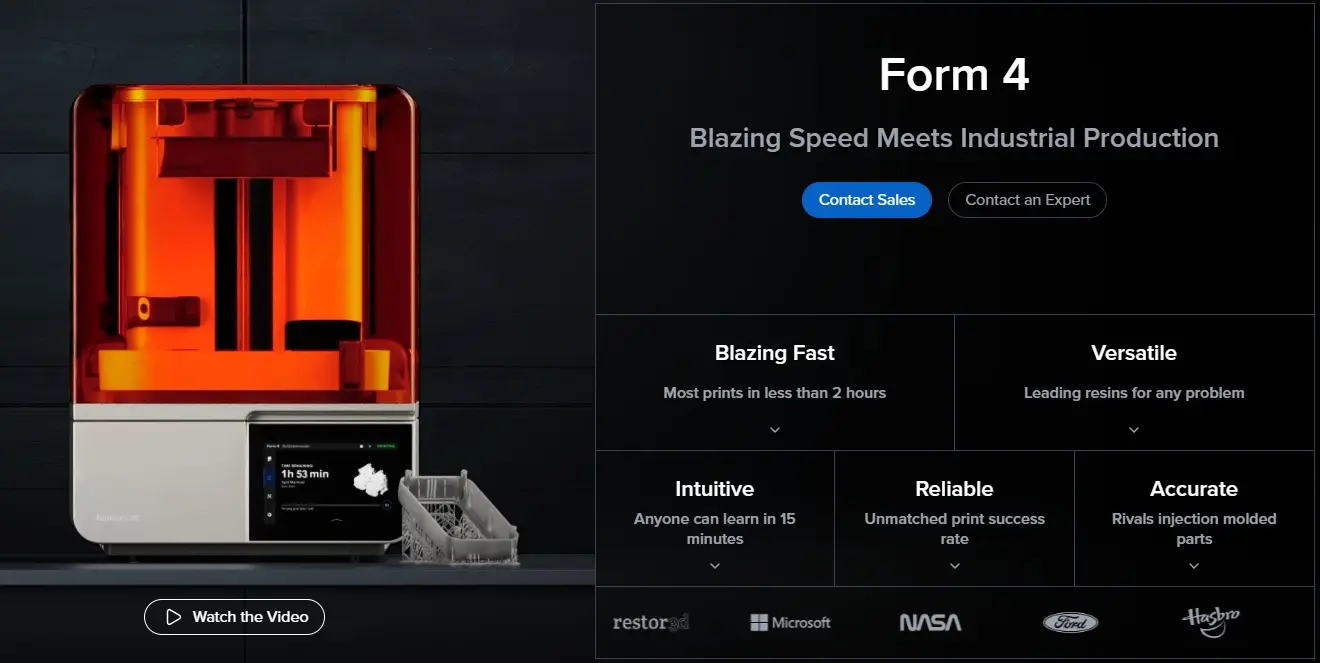
The Formlabs Form 4 is a high-performance SLA (Stereolithography) 3D printer designed for precise and detailed printing. It is particularly popular in industries requiring high-quality prototypes, such as dental and jewelry sectors.Key Features:
- Build Volume: 145 x 145 x 175 mm
- Layer Thickness: Adjustable from 25 to 100 microns
- Laser Technology: Utilizes a UV laser for curing resin
- Material Compatibility: Supports a wide range of resins including standard, tough, flexible, and specialty materials.
- User Interface: Equipped with a touchscreen for easy navigation and control.
- Connectivity: Wi-Fi, Ethernet, and USB options available for file transfer.
The Formlabs Form 4 is known for its user-friendly design and robust software integration, making it suitable for both beginners and experienced users.
Kings3D Printer – Kings SLA 400
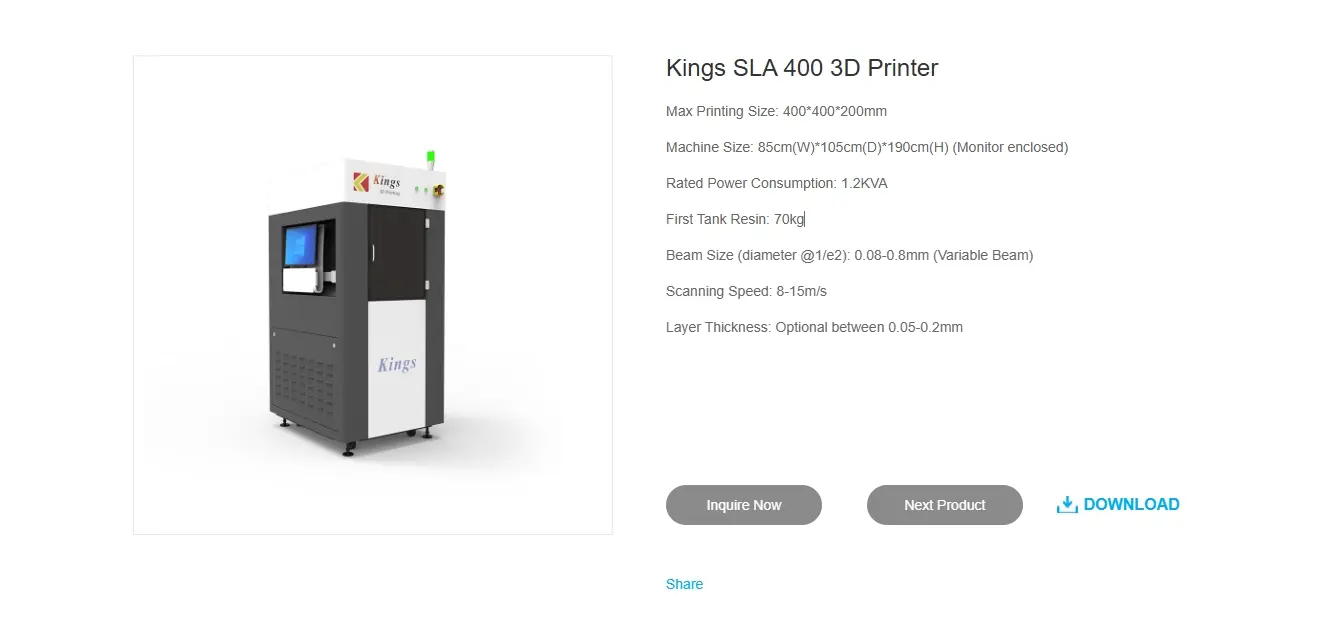
The Kings SLA 400 is an industrial-grade SLA printer aimed at high-precision applications, particularly in dental and prototyping industries.Specifications:
- Build Volume: 400 x 400 x 400 mm
- Layer Thickness: Ranges from 0.05 to 0.25 mm
- Laser Type: Nd:YVO4 Solid Laser
- Resolution: Up to 50 microns
- Scanning Speed: Maximum of 10.0 m/s
- Weight: Approximately 450 kg
- Material Types: Compatible with various resins including castable and flexible options.
This printer is designed for rapid prototyping with a focus on producing high-quality parts with intricate details
Zongheng3D Super Maker SLA-400
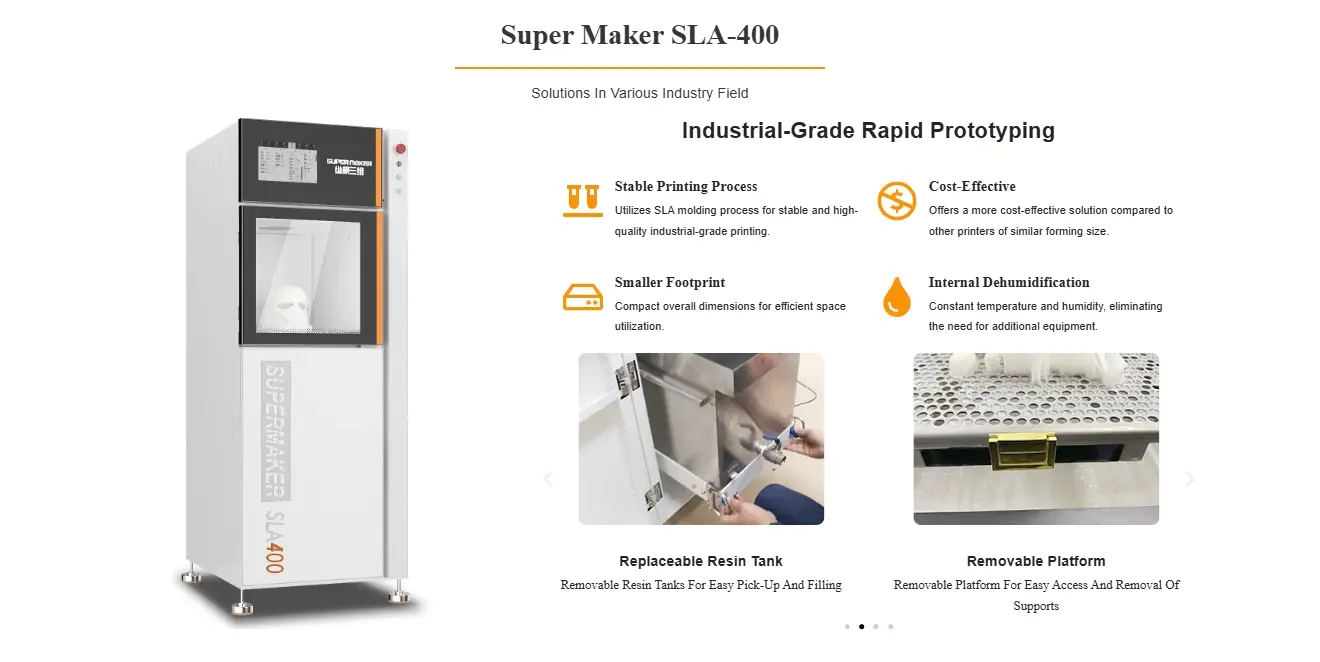
The Super Maker SLA-400 by Zongheng3D is another advanced SLA printer that emphasizes precision and versatility in printing.Key Features:
- Build Volume: 400 x 400 x 350 mm (customizable)
- Layer Thickness: Capable of achieving resolutions as low as 25 microns
- Laser Type: Customized UV laser with spot sizes between 0.08 mm to 0.15 mm
- Scanning Mode: Galvo scanning with a scraper mechanism for efficient resin handling.
- Weight: Approximately 320 kg (without materials)
- Data Interface: SLC compatible
This model is ideal for creating complex geometries and detailed prototypes suitable for various applications from product demonstrations to intricate figurines
These three printers reflect the advancements in SLA technology, catering to diverse needs from industrial applications to high-detail prototyping.
Workflow Integration
Incorporating SLA 3D Printing into Your Production Line
Integrating SLA 3D printing into your existing workflow involves several steps:
- Initial Assessment: Evaluate which parts or tools can benefit from SLA 3D printing.
- Design Adaptation: Modify existing CAD models to optimize for SLA printing.
- Printer Setup: Install and calibrate your SLA printer according to manufacturer guidelines.
- Printing Process: Develop a standardized printing process, including resin handling and print settings.
- Post-Processing: Establish a post-processing workflow, including cleaning, curing, and finishing.
Key Considerations for Smooth Integration
- Training: Ensure your team is trained on using SLA 3D printers and related software.
- Quality Control: Implement quality control measures to ensure consistent print quality.
- Maintenance: Regularly maintain your SLA printers to prevent downtime.
Post-Processing Techniques
Essential Post-Processing Steps
Post-processing is a critical part of the SLA 3D printing workflow, impacting the final quality and functionality of your parts. Here are the essential steps:
- Support Removal: Carefully remove support structures using pliers or specialized tools.
- Cleaning: Clean the printed part in an isopropyl alcohol (IPA) bath to remove uncured resin.
- Curing: Cure the part under UV light to achieve the desired mechanical properties.
- Sanding and Finishing: Sand and polish the part to improve surface finish and remove any remaining layer lines.
Advanced Post-Processing Options
- Painting and Coating: Apply paints or coatings to enhance appearance or add functionality.
- Machining: Perform secondary machining operations for features requiring higher precision.
- Bonding: Use adhesives or welding techniques to assemble larger parts from multiple prints.
Post-Processing Tools and Supplies
| Tool/Supply | Purpose |
| Pliers/Flush Cutters | Remove support structures |
| IPA Bath | Clean uncured resin |
| UV Curing Chamber | Cure parts to improve mechanical properties |
| Sandpaper/Polishing Kits | Finish surfaces |
| Paints/Coatings | Enhance appearance or functionality |
Implementing SLA 3D printing in your production processes can offer significant advantages in terms of speed, cost, and precision. By carefully considering design aspects, selecting the right equipment, integrating the technology into your workflow, and mastering post-processing techniques, you can unlock the full potential of SLA 3D printing for custom tooling and other applications.
Future Trends and Innovations in SLA 3D Printing
As SLA 3D printing continues to evolve, new trends and innovations are emerging that promise to further enhance its capabilities and applications. This article will explore some of the most exciting future trends in SLA 3D printing, including advancements in materials, improvements in printer technology, and the integration of AI and machine learning. By understanding these trends, you can stay ahead of the curve and leverage the latest developments to optimize your production processes.
Advancements in Materials
Developments in Resin Formulations
The range of resins available for SLA 3D printing is constantly expanding, offering new possibilities for custom tooling and other applications. Key advancements include:
- High-Performance Resins: New formulations with enhanced mechanical properties, such as increased strength, flexibility, and heat resistance.
- Bio-Compatible Resins: Improved bio-compatible resins for medical and dental applications, ensuring safety and performance.
- Conductive Resins: Development of resins with conductive properties, opening up new possibilities in electronics and sensor manufacturing.
Emerging Resin Types and Their Applications
| Resin Type | Properties | Applications |
| High-Performance Resins | Increased strength, flexibility | Functional prototypes, end-use parts |
| Bio-Compatible Resins | Safe for medical use | Dental models, medical devices |
| Conductive Resins | Conducts electricity | Electronics, sensors |
| Ceramic-Filled Resins | High temperature and wear resistance | Industrial tooling, aerospace components |
Case Study: High-Performance Resins in Aerospace
An aerospace company utilized newly developed high-performance resins to produce lightweight, high-strength components for aircraft interiors. The advanced material properties allowed them to achieve performance levels previously unattainable with traditional materials.
Case Study: Faster Printing in Automotive Prototyping
An automotive manufacturer adopted a new SLA printer with increased print speeds to produce custom jigs and fixtures. The reduced print times allowed for quicker iterations and faster production cycles, significantly streamlining their workflow.
Improvements in Printer Technology
Higher Resolution and Faster Printing Speeds
Recent advancements in SLA printer technology are pushing the boundaries of resolution and speed. Innovations include:
- Ultra-High Resolution: New printers capable of achieving resolutions below 20 microns, enabling even finer details.
- Increased Print Speeds: Enhanced laser and light engine technologies that significantly reduce print times without compromising quality.
- Larger Build Volumes: Development of printers with larger build volumes, allowing for the production of bigger parts in a single print.
Integration of AI and Machine Learning
AI-Driven Design Optimization
Artificial Intelligence (AI) and machine learning are being integrated into SLA 3D printing workflows to optimize designs and enhance print quality. Key applications include:
- Generative Design: AI algorithms generating optimized designs based on specified constraints and performance criteria.
- Error Detection: Machine learning models predicting and identifying potential print failures before they occur.
- Process Optimization: AI-driven adjustments to print settings in real-time to ensure optimal print quality.
AI and Machine Learning Applications in SLA Printing
| Application | Description |
| Generative Design | AI-generated designs optimized for performance and material efficiency |
| Error Detection | Predict and identify potential print failures |
| Process Optimization | Real-time adjustments to print settings |
| Quality Assurance | Automated inspection and quality control |
Case Study: AI-Driven Error Detection in Medical Device Manufacturing
A medical device manufacturer implemented an AI-driven error detection system in their SLA 3D printing workflow. The system significantly reduced print failures by detecting potential issues early in the process, ensuring higher quality and consistency in their products.
Sustainable Practices
Eco-Friendly Resins and Recycling
As sustainability becomes increasingly important, the development of eco-friendly resins and recycling initiatives is gaining momentum. Innovations include:
- Biodegradable Resins: Development of resins that break down naturally over time, reducing environmental impact.
- Recycling Programs: Initiatives to recycle and reuse waste resin, minimizing material waste and promoting sustainability.
Sustainable Practices in SLA 3D Printing
| Practice | Description |
| Biodegradable Resins | Resins that break down naturally |
| Recycling Programs | Initiatives to recycle and reuse waste resin |
| Energy-Efficient Printers | Printers designed to consume less energy |
| Sustainable Packaging | Eco-friendly packaging for resin and printer components |
Case Study: Sustainable Practices in Consumer Products
A consumer products company adopted biodegradable resins and implemented a recycling program for their SLA 3D printing operations. These sustainable practices not only reduced their environmental footprint but also resonated positively with eco-conscious customers.
Conclusion
The future of SLA 3D printing is bright, with numerous exciting trends and innovations on the horizon. Advancements in materials, improvements in printer technology, the integration of AI and machine learning, and sustainable practices are set to revolutionize the industry. By staying informed about these trends and adopting the latest technologies, you can maximize the potential of SLA 3D printing and stay ahead in the competitive landscape.
We hope this comprehensive guide has provided valuable insights into the world of SLA 3D printing. Whether you’re looking to optimize your current processes or explore new possibilities, embracing these future trends will position you for success in the evolving landscape of 3D printing.

